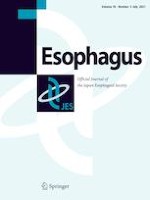Erschienen in:

21.01.2021 | Original Article
Validity of endoscopic resection for clinically diagnosed T1a-MM/T1b-SM1 N0 M0 esophageal squamous cell carcinoma
verfasst von:
Katsunori Matsueda, Noriko Matsuura, Takashi Kanesaka, Ayaka Shoji, Takahiro Inoue, Muneaki Miyake, Kotaro Waki, Hiromu Fukuda, Satoki Shichijo, Akira Maekawa, Sachiko Yamamoto, Yoji Takeuchi, Koji Higashino, Noriya Uedo, Tomoki Michida, Ryu Ishihara
Erschienen in:
Esophagus
|
Ausgabe 3/2021
Einloggen, um Zugang zu erhalten
Abstract
Background
Previous guidelines have not described clear recommendations for performing endoscopic resection (ER) of T1a-muscularis mucosa (MM)/T1b-submucosal (SM1) cancers that have invaded ≤ 200 μm because these are considered to have a non-negligible risk of metastasis based on previous analyses of pathologically diagnosed (p)MM/SM1 cancers. Considering that the indication for ER is determined based on a clinical diagnosis, the applicability of ER should be investigated in clinical (c)MM/SM1 but not pMM/SM1 cancers. This study aimed to evaluate validity of ER for cMM/SM1 cancers.
Methods
In total, 175 cMM/SM1 esophageal squamous cell carcinoma cases that were endoscopically or surgically resected between January 2008 and December 2018 were identified from a prospectively maintained database. We histologically evaluated resected specimens and divided them into low- (n = 92) and high-risk (n = 83) cancers for metastasis.
Results
Univariate analysis showed that longer tumor length and larger circumferential extent were significantly correlated with high-risk cancer (P < 0.001). Multivariate analysis showed that tumor circumference was an independent predictor of high-risk cancer (P = 0.036). The proportion of low-risk cancers among cases with ≤ 3/4, > 3/4 and < 1, and whole circumferential extent were 59, 17, and 14%, respectively, and the post-ER stricture rates of these groups were 12, 33, and 100%, respectively.
Conclusion
ER is the first-line treatment for cMM/SM1 cancers with ≤ 3/4 circumferential extent considering that 59% of cMM/SM1 cancers were low-risk cancers for which ER is mostly curative. ER is not recommended for whole circumferential cMM/SM1 cancers given the low proportion of low-risk cancers and the high risk of stricture after ER.